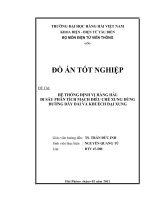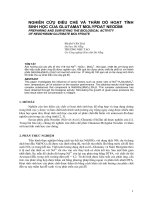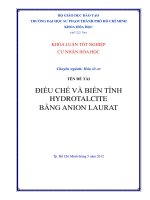Điều chế xung biên độ PAM
Bạn đang xem bản rút gọn của tài liệu. Xem và tải ngay bản đầy đủ của tài liệu tại đây (321.38 KB, 62 trang )
3F4 Pulse Amplitude Modulation
(PAM)
Dr. I. J. Wassell
Introduction
•
The purpose of the modulator is to convert
discrete amplitude serial symbols (bits in a
binary system) a
k
to analogue output pulses
which are sent over the channel.
•
The demodulator reverses this process
Modulator Channel Demodulator
Serial data
symbols
a
k
‘analogue’
channel pulses
Recovered
data symbols
Introduction
•
Possible approaches include
–
Pulse width modulation (PWM)
–
Pulse position modulation (PPM)
–
Pulse amplitude modulation (PAM)
•
We will only be considering PAM in these
lectures
PAM
•
PAM is a general signalling technique
whereby pulse amplitude is used to convey
the message
•
For example, the PAM pulses could be the
sampled amplitude values of an analogue
signal
•
We are interested in digital PAM, where the
pulse amplitudes are constrained to chosen
from a specific alphabet at the transmitter
PAM Scheme
H
C
(
ω
)
h
C
(t)
Symbol
clock
H
T
(
ω
) h
T
(t)
Noise N(
ω
)
Channel
+
Pulse
generator
a
k Transmit
filter
∑
∞
−∞=
−=
k
ks
kTtatx )()(
δ
∑
∞
−∞=
−=
k
Tk
kTthatx )()(
Receive
filter
H
R
(
ω
), h
R
(t)
Data
slicer
Recovered
symbols
Recovered
clock
)()()( tvkTthaty
k
k
+−=
∑
∞
−∞=
Modulator
Demodulator
PAM
•
In binary PAM, each symbol a
k
takes only
two values, say {A
1
and A
2
}
•
In a multilevel, i.e., M-ary system, symbols
may take M values {A
1
, A
2
, A
M
}
•
Signalling period, T
•
Each transmitted pulse is given by
)( kTtha
Tk
−
Where h
T
(t) is the time domain pulse shape
PAM
•
To generate the PAM output signal, we may
choose to represent the input to the transmit
filter h
T
(t) as a train of weighted impulse
functions
∑
∞
−∞=
−=
k
ks
kTtatx )()(
δ
•
Consequently, the filter output x(t) is a train of
pulses, each with the required shape h
T
(t)
∑
∞
−∞=
−=
k
Tk
kTthatx )()(
PAM
•
Filtering of impulse train in transmit filter
Transmit
Filter
∑
∞
−∞=
−=
k
Tk
kTthatx )()(
∑
∞
−∞=
−=
k
ks
kTtatx )()(
δ
)(th
T
)(tx
s
)(tx
PAM
•
Clearly not a practical technique so
–
Use a practical input pulse shape, then filter to
realise the desired output pulse shape
–
Store a sampled pulse shape in a ROM and read out
through a D/A converter
•
The transmitted signal x(t) passes through the
channel H
C
(
ω
) and the receive filter H
R
(
ω
).
•
The overall frequency response is
H(
ω
) = H
T
(
ω
) H
C
(
ω
) H
R
(
ω
)
PAM
•
Hence the signal at the receiver filter output is
)()()( tvkTthaty
k
k
+−=
∑
∞
−∞=
Where h(t) is the inverse Fourier transform of H(
ω
)
and v(t) is the noise signal at the receive filter
output
•
Data detection is now performed by the Data
Slicer
PAM- Data Detection
•
Sampling y(t), usually at the optimum instant
t=nT+t
d
when the pulse magnitude is the
greatest yields
n
k
dkdn
vtTknhatnTyy
++−=+=
∑
∞
−∞=
))(()(
Where v
n
=v(nT+t
d
) is the sampled noise and t
d
is the
time delay required for optimum sampling
•
y
n
is then compared with threshold(s) to determine
the recovered data symbols
PAM- Data Detection
Data Slicer decision
threshold = 0V
0
Signal at data
slicer input, y(t)
Sample clock
Sampled signal,
y
n
= y(nT+t
d
)
Ideal sample instants
at t = nT+t
d
0
TX data
TX symbol, a
k
‘1’ ‘0’ ‘0’ ‘1’ ‘0’
+A -A -A +A -A
Detected data ‘1’ ‘0’ ‘0’ ‘1’ ‘0’
Τ
t
d
Synchronisation
•
We need to derive an accurate clock signal at
the receiver in order that y(t) may be sampled at
the correct instant
•
Such a signal may be available directly (usually
not because of the waste involved in sending a
signal with no information content)
•
Usually, the sample clock has to be derived
directly from the received signal.
Synchronisation
•
The ability to extract a symbol timing clock
usually depends upon the presence of transitions
or zero crossings in the received signal.
•
Line coding aims to raise the number of such
occurrences to help the extraction process.
•
Unfortunately, simple line coding schemes often
do not give rise to transitions when long runs of
constant symbols are received.
Synchronisation
•
Some line coding schemes give rise to a
spectral component at the symbol rate
•
A BPF or PLL can be used to extract this
component directly
•
Sometimes the received data has to be non-
linearly processed eg, squaring, to yield a
component of the correct frequency.
Intersymbol Interference
•
If the system impulse response h(t) extends over
more than 1 symbol period, symbols become
smeared into adjacent symbol periods
•
Known as intersymbol interference (ISI)
•
The signal at the slicer input may be rewritten as
n
nk
dkdnn
vtTknhathay
++−+=
∑
≠
))(()(
–
The first term depends only on the current symbol a
n
–
The summation is an interference term which
depends upon the surrounding symbols
Intersymbol Interference
•
Example
–
Response h(t) is Resistor-Capacitor (R-C) first
order arrangement- Bit duration is T
•
For this example we will assume that a
binary ‘0’ is sent as 0V.
Time (bit periods)
0 2 4 6
amplitude
0.5
1.0
Time (bit periods)
0 2 4 6
amplitude
0.5
1.0
Modulator input Slicer input
Binary ‘1’ Binary ‘1’
Intersymbol Interference
•
The received pulse at the slicer now extends
over 4 bit periods giving rise to ISI.
•
The actual received signal is the
superposition of the individual pulses
time (bit periods)
0 2 4 6
amplitude
0.5
1.0
‘1’ ‘1’ ‘0’ ‘0’ ‘1’ ‘0’ ‘0’ ‘1’
Intersymbol Interference
•
For the assumed data the signal at the slicer
input is,
•
Clearly the ease in making decisions is data
dependant
time (bit periods)
0 2 4 6
amplitude
0.5
1.0
Note non-zero values at ideal sample instants
corresponding with the transmission of binary ‘0’s
‘1’ ‘1’ ‘0’ ‘0’ ‘1’ ‘0’ ‘0’ ‘1’
Decision threshold
Intersymbol Interference
•
Matlab generated plot showing pulse
superposition (accurately)
0 1 2 3 4 5 6 7 8
0
0.1
0.2
0.3
0.4
0.5
0.6
0.7
0.8
0.9
Decision
threshold
time (bit periods)
Received
signal
Individual
pulses
amplitude
Intersymbol Interference
•
Sending a longer data sequence yields the
following received waveform at the slicer input
Decision
threshold
0 10 20 30 40 50 60 70
0
0.1
0.2
0.3
0.4
0.5
0.6
0.7
0.8
0.9
1
0 10 20 30 40 50 60 70
0
0.1
0.2
0.3
0.4
0.5
0.6
0.7
0.8
0.9
1
Decision
threshold
(Also showing
individual pulses)
Eye Diagrams
•
Worst case error performance in noise can be
obtained by calculating the worst case ISI over all
possible combinations of input symbols.
•
A convenient way of measuring ISI is the eye
diagram
•
Practically, this is done by displaying y(t) on a
scope, which is triggered using the symbol clock
•
The overlaid pulses from all the different symbol
periods will lead to a criss-crossed display, with
an eye in the middle
Example R-C response
Eye Diagram
Decision
threshold
Optimum sample instant
h = eye height
0 0.1 0.2 0.3 0.4 0.5 0.6 0.7 0.8 0.9
0
0.1
0.2
0.3
0.4
0.5
0.6
0.7
0.8
0.9
1
h
Eye Diagrams
•
The size of the eye opening, h (eye height)
determines the probability of making incorrect
decisions
•
The instant at which the max eye opening occurs
gives the sampling time t
d
•
The width of the eye indicates the resilience to
symbol timing errors
•
For M-ary transmission, there will be M-1 eyes
Eye Diagrams
•
The generation of a representative eye
assumes the use of random data symbols
•
For simple channel pulse shapes with binary
symbols, the eye diagram may be
constructed manually by finding the worst
case ‘1’ and worst case ‘0’ and
superimposing the two









